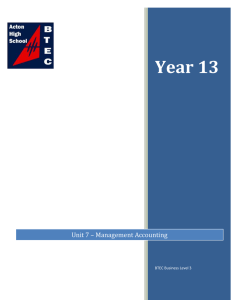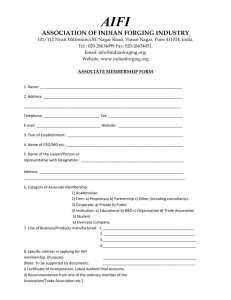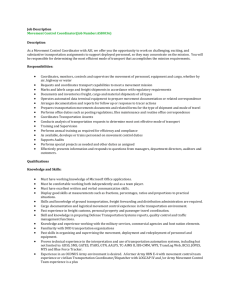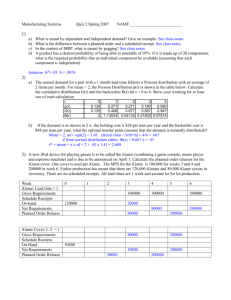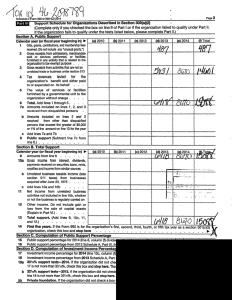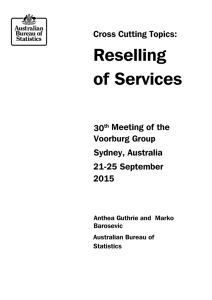30th Voorburg Group Meeting on Services Statistics Sydney, Australia
advertisement
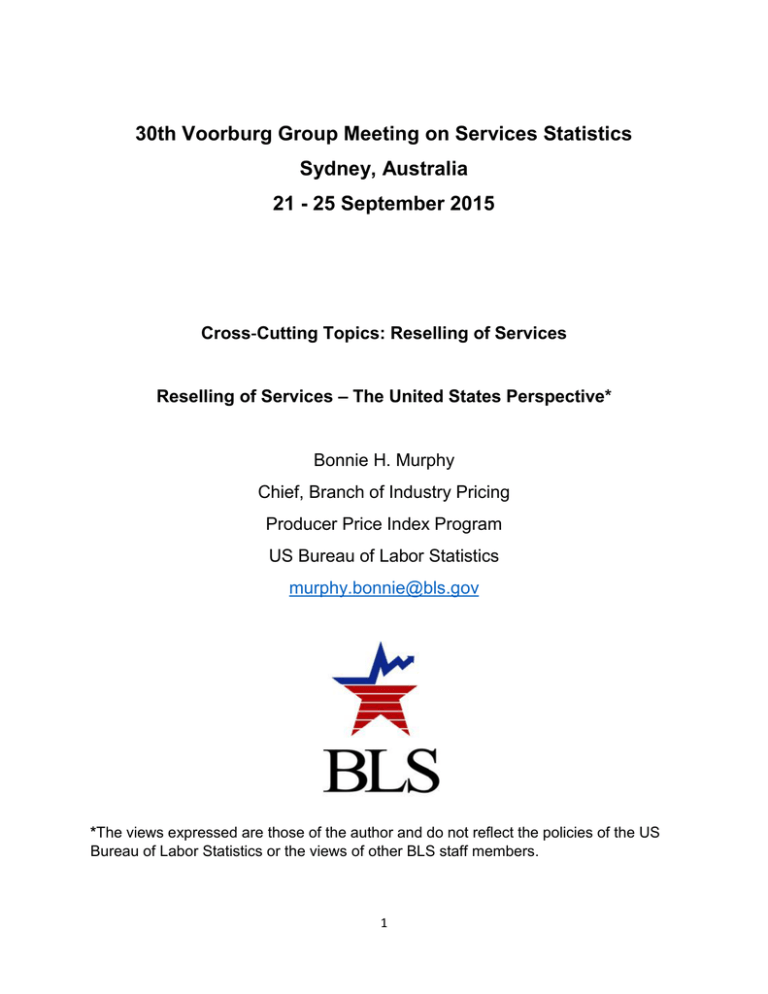
30th Voorburg Group Meeting on Services Statistics Sydney, Australia 21 - 25 September 2015 Cross‐Cutting Topics: Reselling of Services Reselling of Services – The United States Perspective* Bonnie H. Murphy Chief, Branch of Industry Pricing Producer Price Index Program US Bureau of Labor Statistics murphy.bonnie@bls.gov *The views expressed are those of the author and do not reflect the policies of the US Bureau of Labor Statistics or the views of other BLS staff members. 1 This paper examines the issue of the economic measurement of reselling of services. The factors that need to be considered in order to determine whether an entity is reselling a service are presented and a definition of reselling of services is provided. Following that is a discussion of the US experience in capturing this service, both in terms of turnover and price measurement. Discussion of the potential classification issues that arise depending on how reselling of services transactions are measured is also presented. In a perfect world, turnover measures would be consistent with price measures and both should be able to be easily accommodated with firm record keeping practices. The potential impact on National accounting for these reselling of services transactions is large if they are measured incorrectly (the difference in turnover for a transaction measured as gross sales rather than net margin or agent fees is substantial) and National Statistical Offices (NSOs) must also guard against double counting or over-inflation of turnover both within and across country borders. The accuracy of the National Accounts is also dependent on using matching concepts and methodologies to capture both price deflators and turnover statistics for all or part of an industry. Definition A definition of what is included specifically as reselling of services is necessary. In determining how to define and measure these types of transactions, both in terms of turnover and pricing, a number of factors must be considered. The initial step is to determine whether the firm is obligated to provide the service itself (the firm is acting as the principal provider and total gross turnover is measured and the price is captured as the total amount received from the buyer) or whether the firm is arranging for a third party to have the services provided to the buyer. In the latter case, the firm is acting as an agent and receives payment in the form of a commission, fee, or a margin in some cases. The service provider’s fee might also be the net amount that the provider retains after paying the third party for delivery of the service. This paper will describe reselling of services as one of the activities performed by a firm acting as an agent. What factors must be considered when determining whether the firm is the principal or is acting as an agent in delivering a service? One must decide whether any transformation of the service has occurred and determine whether the firm bears both inventory and/or credit risk. There is currently much discussion among members of the Financial Accounting Standards Board (FASB) and the International Accounting Standards Board (IASB) as to which, if any, of these factors should receive consideration in determining whether an entity controls the service before transfer to the customer. Control of the service is paramount in the decision of whether the entity is acting as the principal versus an agent. There are different views on whether inventory risk is applicable in intangible or services arrangements. They are negotiating proposed changes to accounting rules (that will be effective in 2018) that will determine how transactions are reported and whether companies record transactions as gross (i.e. the company acts as the principal or provider of the service) or net revenue (the company acts as an agent and receives a fee or commission) for those transactions.i In addition, it may be helpful to know whether the firm obtains legal title to the service before transferring it to the ultimate customer. However, if that legal transfer occurs only momentarily before the transfer to the customer, it does not necessarily mean the firm is acting as the principal. Lastly, if the firm does not have discretion in establishing prices for the contracted third party’s services, they would likely be acting as an agent. 2 Since it can be difficult to determine when transformation of a service has occurred, some further discussion is provided. The definition of transformation services follows: “Changeeffecting services are outputs produced to order and typically consist of changes in the conditions of the consuming units realized by the activities of producers at the demand of the consumers. They can also be referred to as “transformation services”. They can change the condition of the consumer’s goods, or the physical or mental condition of persons.”ii When a service purchased from a third party has undergone any substantial transformation before being provided to the customer, it is an indication that the firm that purchased the service is acting as the principal and not as an agent. Bundling of goods and services to create a distinct service is considered transformation. Bundling often involves subcontracting. “Subcontracting refers to the fact that a principal, who is contracted to provide a specific service that he would normally provide himself, decides not to do so, either because he is not in a position to render it at the time the service should be or he has decided not to deliver it himself as a consequence of a business model he has established.”iii An example of this occur in the software publishing industry when the coding of the software is subcontracted to another firm. The subcontracted coding service is considered an input cost to the final software product. The primary activity of the software publisher is not coding of software so this is a good indication that the software publisher is acting as the principal provider (prices and turnover for software publishers are appropriately measured as gross receipts). It may be helpful here to distinguish between a service that is subcontracted and one that is resold. A resold service is, by definition, not transformed into a new product. A good example of this occurs in the Call Centers industry. Using an example that was discussed during the 2014 Voorburg meeting, if Call Center A cannot provide the volume of call center services required by Customer C, Call Center A “subcontracts” with Call Center B to handle the additional volume. Since both Call Center A and Call Center B perform the primary activity of provision of call center services and Call Center B provides the same service without transformation directly to the final consumer, Call Center A is acting as an agent. The service that Call Center B provides should be classified as a resold service and Call Center A receipts should include only the margin receipts they retain after paying Call Center B for the additional service. From these examples, it follows that the primary or secondary activity of the firm (as compared to that of the subcontracted firm) helps define which subcontracted services should be treated as input costs and which services should be considered resold services. Another indicator of whether a firm is acting as an agent or acting as the principal provider when a third party is involved in the transaction is whether or not they have inventory or credit risk for the contracted services. Inventory risk is the risk that a company will be unable to sell its supply of goods (or services in this case) or that the value of those services will go down. Credit risk is similar in that a company is obligated to pay for the service and the risk is that they will default on that payment. If a firm is acting as an agent in arranging for a third party to provide a service, they would not have purchased the service from the third party so they would not have inventory risk. The agent is also not exposed to credit risk for the amount receivable from the customer. Reselling of services occurs when a company purchases a service that is then promptly sold, without transformation, to another entity. This can be seen as analogous to the reselling of goods that occurs in retail trade. As with goods, a firm that is reselling services does not have discretion in establishing prices for the service they are purchasing from the third party and reselling. An argument can be made that the lack of transformation qualifies the reselling service as one that is provided by an agent. While inventory risk determination is straightforward with respect to reselling of goods, it is less clear with services that are intangible. 3 Unlike goods, the resold service is not actually held in inventory, it is provided directly to the consumer from the third party. In terms of price and turnover measurement, agent services are measured as net receipts and this is also appropriate for relling of services. When an agent provides the service of bringing buyer and seller together, no services are bought or resold and transactions are typically captured as fees or commissions (an example is the case of real estate agents who bring buyer and seller together but they do not purchase the home they are selling). Acquiring services and reselling them is distinct from the service of bringing together buyer and seller and these transactions are more appropriately measured as margins (the difference in the cost of the service and the price at which they are resold). The 2008 SNA (para. 6.21) defines margin services as follows: Margin services result when one institutional unit facilitates the change of ownership of goods, knowledge capturing products, some services or financial assets between two other institutional units.iv It should be noted here that the term merchanting of services is often used in the literature to describe agent services, more specifically the facilitation of the provision of services by an arranger. This term seems to include both the fee and commission based services and the margin based reselling of services. Reselling of services occurs within a country’s borders (as will be illustrated in examples from the US SPPI presented in this paper) and across borders as well. Economic measurement becomes even more difficult when, for example, an entity in country A purchases services in country B and promptly sells them, without transforming them in any way, to a client in another country (C). In what industries is the issue prevalent? Unless otherwise specified, both the North American Industry Classification System (NAICS) and the International Standard Industrial Classification of All Economic Activities (ISIC, Rev.4) classify reselling of a service in the industry of the service that is being resold. NAICS does specifically identify a few industries where reselling of services is the primary activity and the services of these industries are not included in the industry of the service being resold. Examples include Telecommunications Resellers (NAICS 517911) and Freight Transportation Arrangement (NAICS 488510). Telecommunications resellers purchase access and network capacity from owners and operators of telecommunications networks and resell both wired and wireless telecommunications services to businesses and households. They do not operate transmission facilities and infrastructure. ISIC, Rev. 4 does not separate these resellers into their own industry as they are included as part of the larger Other Telecommunications Activities (6190) industry. Freight Transportation Arrangement includes those that arrange the transportation of freight between shippers and carriers. Usually known as freight forwarders, these establishments offer services that include many different modes of transportation. In this case also, ISIC does not have a separate industry for these establishments. Freight forwarders are included as part of ISIC 5229, Other Transportation Support Activities. Reselling of services is generally most prevalent in transportation related industries, telecommunications industries (both wired and wireless), and in industries where “virtual” products are provided over the internet. Electronic tickets for events, vouchers for restaurants, 4 and prepaid gift cards are common products that can be sold within establishments across industries (usually as secondary activity). What challenges does the issue present to following existing product and industry classifications? Currently, goods that are bought and resold within establishments classified in any sector other than retail and wholesale trade are measured as a miscellaneous secondary activity (miscellaneous receipts) and are measured as gross sales. Services that are resold are classified as a primary activity in the service industry where the ultimate resold service is provided and they are also measured as gross receipts. This classification is inconsistent if resold services are thought to be analogous to resold goods. A classification issue can arise if an establishment provides both services where they act as the principal service provider and receive and record gross revenue and they also provide services that they have acquired from others (i.e. they resell services). If only a single gross operating receipts turnover measure is captured for all transactions in an industry (including both types of transactions), classification would then be determined based on the gross receipts of both activities. The reselling services should be recorded as net revenue in the form of a margin or possibly a fee or commission. If turnover statistics were captured distinctly as gross for services provided as the principal and as net for reselling activities, industry classification could change depending on the volume of services provided in each category. As currently classified, the sale of pre-paid gift cards (specifically for those services NOT provided at the collected unit) are included within the many industries that arrange for the sale of gift cards to the consumer and the revenue generated can be substantial (although less so if these transactions are captured and recorded as net revenues). The classification challenge is in determining whether the service provided when the gift card is redeemed by the consumer is actually what is being transacted and should that ultimate transaction be the basis of both industry and product classification? It could be argued that the consumer is purchasing a card with a type of currency that can be used only at the specified establishment. The sale of gift cards would then potentially be classified as a currency exchange. How is the issue treated in turnover statistics? – identify best practices or potential approaches for turnover statistics. In the US, turnover statistics captured by the Census Bureau for the Economic Census include services that are resold as primary receipts of the resold service (i.e. they are not readily identifiable as distinct from the services that are provided by service establishments acting as a principal). One exception is that distinct reselling of services turnover statistics are identifiable for the few specific industries that are defined solely by reselling activities. An examination of turnover measurement of two such service reselling industries yielded inconsistent results, however. For the Freight Transportation Arrangement (NAICS 488510), the US Census Bureau collects net operating revenue. Specifically, shipping agents and brokers in this industry are directed to include commissions, not gross charges. Freight forwarders are instructed to report the 5 difference between the gross charges and the amounts paid to other transportation companies, also, appropriately, net revenues. In contrast, for Telecommunications Resellers (NAICS 517911), establishments report gross operating receipts. There is only one form used to capture turnover for all of the Telecommunications industries so a separate means of collection of “net receipts” for Telecommunications Resellers is not available. In the Census Bureau’s Services Annual Survey, an expense category for “access charges” is captured. This expense could be subtracted from the gross receipts captured in the Economic Census and net revenues could be determined. The issue is that the expense category is collected at the 4-digit NAICS level and cannot be specifically applied to Telecommunications Resellers at the 6-digit NAICS industry level. Turnover statistics for other industries that are characterized by fee or commission based transactions are correctly captured in the Economic Census as net receipts. Travel Agencies and Insurance Agents and Brokers are examples of industries that include agents that primarily provide the service of bringing a buyer and seller together. In fact, the instruction for reporting revenues for the travel agencies industry specifically states that gross sales should NOT be reported. Reselling of services also occurs in the travel agency industry. While margin revenues from resold services cannot be specifically identified, the industry level turnover statistic correctly accounts for these services because all turnover is measured as net receipts. Suggested best practices The first suggested best practice is to establish a consistent net measurement of turnover for industries that are specifically created to capture reselling of services. In the US, this would mean that net operating receipts should be able to be calculated for Telecommunications Resellers. If one assumes that reselling of services is analogous to reselling of goods, a potential approach similar to that used for the measurement of turnover in retail and wholesale trade should be considered. For reselling of goods in retail and wholesale trade, the Annual Survey for Retail and Wholesale Trade captures the cost of goods sold which allows the gross margin (the difference between gross sales and cost of goods sold) to be specifically measured in these industries. Since reselling of services is currently primarily measured as gross revenues, a specific expense category could be added for the “cost of resold services”. This expense could be used to net out that cost so that gross margin for resold services could then be included in a new/additional total turnover measure. Note that the US also produces wherever provided service product price indexes that are weighted using Economic Census data and the consistent net measurement of all resold services would lead to more accurate weights for those services in these indexes. On a related note, an expense category for cost of goods sold for all resold goods captured across all industries, not just retail and wholesale trade, should also be added to all of the Annual Surveys. Currently, goods that are bought and resold within establishments classified in any sector other than retail and wholesale trade are measured as a miscellaneous secondary activity (miscellaneous receipts) and are measured as gross sales. The addition of this expense category for all resold goods would allow the calculation of gross margin turnover statistics for products provided from across all industries on a wherever-made basis. This measure is currently limited to products sold within retail and wholesale trade establishments. 6 How is the issue handled in various SPPIs? – identify best practices or potential approaches for SPPI. Although the US PPI experience in measuring fees and commissions for agent and brokerage services is vast, there are surprisingly few examples of reselling of services. Perhaps this is due to the fact that when disaggregation is performed at a sampled unit in the SPPI, resold services are given a relative importance based on the net revenues received for this service by the service provider and these net revenues tend to be relatively small in most cases. Probability proportionate to size disaggregation, therefore, would not yield many items to be collected. It could also be the case that firms record revenue for these services as gross receipts and data collectors are unaware that the services collected are actually resold services. Online travel agency – merchant model The US SPPI currently measures reselling of travel booking services within the Travel Agencies industry (NAICS 561510). Online travel agencies (OTAs) in this industry sometimes use a merchant model to book hotel rooms and airline flights. The following excerpt describing the reselling service provided under this model is taken from the US SPPI Industry Synopsis for Travel Agencies: Under the merchant model, OTAs negotiate discounted wholesale prices for a certain amount of a travel supplier’s inventory. For example, an OTA might negotiate with a hotel room supplier in order to have access to a specified number of rooms at a price discounted below the level offered through the Global Distribution Systems. The OTA then adds a markup before posting the price on its website. These merchant model travel bookings are often available through opaque price bookings or opaque brand bookings. Opaque price bookings are usually travel packages where only the total package price is given. The price of each separate part of the travel package is hidden from the customer. Opaque brand bookings may be made through “name your own price” programs or searches by price level where the travel brand is not known until the reservation has been made and the payment has been submitted. For merchant model transactions, OTAs bill travelers when bookings are made. Once the customer is charged, the reservation information is transmitted by the OTA to the travel supplier. The supplier bills the OTA at a later date. For hotels, the supplier typically bills the OTA upon customer checkout. The price for an OTA for merchant model transactions is the markup that is added to the wholesale price of the booking. Because OTAs are only negotiating access to a supplier’s inventory at a reduced price and not committing to purchase the travel inventory before travel customers are found, they will never have to sell the booking at a negative margin.v In summary, since transformation of the service does not occur for the merchant model and the OTA does not take on inventory risk by purchasing the travel service, the US SPPI has accepted that the OTA is acting as an agent in reselling these services and margin pricing is appropriate. Further, an examination of hotel merchant model margin transactions compared to the US SPPI for hotel guestroom rental (measured as gross) over a three year period starting in 2012 showed that the margin transactions exhibited much greater volatility and the long term trend over this period was slightly lower. 7 It should be noted that establishments classified in NAICS 561520, Tour Operators, actually purchase (rather than just gaining access to them as in the merchant model transactions) travel inventory (airline tickets, hotel rooms, etc.) from travel suppliers with the intention of reselling it. Inventory risk is taken. If they are unsuccessful in selling the inventory, they take a loss. The US SPPI does not measure this industry, but theoretically, if follows that the industry services should be priced as a gross measure. Freight forwarding The Freight Transportation Arrangement industry (NAICS 488510) includes companies that arrange for the transportation of freight and they do not actually transport the cargo themselves except pickup service and transport to the warehouse or terminal. These companies are known as freight forwarders, non-vessel operating common carriers (NVOCCs), customs brokers, or freight/shipping agents. They are transportation intermediaries (mediators between shippers and carriers) and must be licensed by Federal Maritime Commission (FMC) or the Federal Motor Carrier Safety Administration (FMCSA). Customs brokers are regulated and licensed by the US Customs and Border Protection (CBP). Freight forwarders and NVOCCs (licensed by the FMC as common carriers but they primarily buy and sell cargo space on steamships and airplanes) provide arrangement of cargo for shipment on behalf of a shipper or a carrier, pay transportation charges as a cost of doing business, and assume financial responsibility for the delivery and care of those goods. They take legal possession of the cargo during the arrangement of the shipment for intermodal export. They are classified in 7-digit Census code 4885101, Freight Forwarding. Cargo liability insurance is regulated by the agency overseeing the transportation of shipment via water, air, rail, and/or truck. Ocean NVOCCs are legally liable for the cargo in their possession and are required by the FMC to have financial responsibility in the amount of $75,000. The FMC requires other Non-NVOCC ocean freight forwarders to have financial responsibility in the amount of $50,000. Other freight forwarders of other transportation modes may or may not be required to have a certain amount of financial responsibility to the cargo in its possession. Cargo liability insurance is a cost of doing business for arrangers. Customs brokers are responsible for the examination or evaluation of the cargo for shipment. Freight/shipping agents or brokers are primarily the carrier’s auxiliary and sales agents. Customs brokers and freight/shipping agents do not have legal liability for the cargo and therefore do not assume financial responsibility for the cargo. They are classified in 7-digit Census code 4885102, Arrangement of transportation of freight and cargo. The main difference between these two Census service lines is freight forwarders undertake the legal responsibility for the cargo during the arrangement of the transportation of the goods which adds more value to the service so they usually charge a higher price. Prices for freight forwarding are captured as margins or spreads, reflecting the difference between gross charges to the customer and the amount paid to other transportation companies that actually transport the cargo. Commissions and contract rates (collected from a SU that performs a high volume of a particular service to the same destination) are also observed. Prices collected for the arrangement of transportation of freight and cargo by customs brokers and freight agents are mainly commissions (the percentage of the total cost of the transportation). 8 Since establishments in the Freight Transportation Arrangement industry arrange for the transportation of cargo, no transformation activities are performed. Some “agents” in this industry assume inventory risk (as indicated by the requirement for cargo liability insurance), and some do not. Inventory risk, in this case, is not a deciding factor in whether or not the establishment is acting as an agent. The reselling service provided in this industry is measured as a net price in the form of margins and spreads (similar to other resold goods and services) and also as a commission. Local telephone service In the Wired Telecommunications Industry (NAICS 517110), local telephone service provided by "local resellers" is captured as a primary service. Local resellers are the same as competitive local exchange carriers, but have no network facilities at all. They offer local service under their own name but utilize leased facilities, hence the term “resellers.” The resellers provide marketing and billing services but the infrastructure is maintained by the lessors of the facilities (local exchange carriers or LECs). These are still carriers, not resellers as defined in Telecommunications Resellers (NAICS 517919). Since these "resellers" provide some value added and they have some transformation of the services by bundling marketing and billing services with the local service, they are not true resellers and the US SPPI captures an actual transaction price which is a composite of charges on a typical telephone bill. Prepaid stored-value cards (i.e. gift cards) The US experience is that reselling of services often occurs as a fee or commission based service and the PPI sometimes collects these as a secondary activity of an industry. An example would be the reselling of both wired and wireless telecommunications carriers’ minutes where the carrier sells minutes to a convenience store that then resells them at the carriers’ price through pre-paid stored-value cards (prepaid cards with monetary values redeemable for goods, services, and/or cash). The convenience store is the sampled unit and would be classified in the appropriate retail trade industry. When the prepaid card is purchased, the carrier is reimbursed for the minutes at a wholesale price. The transaction is measured as the net fee received by the convenience store for acting as the “agent” in arranging for the sale of the minutes. The convenience store assumes no risk in this transaction. Accounting rules actually require the carrier to record the value of the pre-paid card as a liability until the card is redeemed by the customer.vi Reselling of minutes (which is classified in telecommunications) is a secondary activity of the convenience store. Web hosting add-on service While doing research for this paper, one additional service was discovered that likely should be considered reselling of services. Web design firms, developers, or systems integrators offer web hosting as an add-on service. This provides an inexpensive method for new web hosting companies to start their business. The web design firm buys the service from the company that actually does the web hosting at a wholesale price and resells at a profit. This service is likely classified in Data Processing, Hosting, and Related Services (NAICS 518210). Further research is needed to determine the prevalence of this reselling service and to investigate whether the US SPPI has any web hosting items that are actually resold services. 9 Suggested best practices SPPIs should be aware of the methodology used in turnover statistics in pricing reselling of services. The pricing methodology should match the turnover measurement to ensure accuracy in the National Accounts. A suggested best practice for SPPI would be to attempt to identify the prevalence of reselling of services in an industry before data is collected. During disaggregation (whether at the establishment as in the US or during product selection prior to data collection), resold services should be weighted using net revenues, therefore, giving them an appropriately smaller chance of selection. Resold services, as analogous to resold goods, should be collected as a margin. Both the “wholesale” price that is paid by the firm to acquire the service and the price at which the service is resold to the customer could be collected so that users are able to match the prices to different turnover measures that might be captured. How does the issue impact the country’s National Accounts’ calculation of volume of services outputs? The 2008 System of National Accounts, the Balance of Payments Manual sixth edition (BPM6) and the Manual on Statistics of International Trade in Services 2010 (MSITS 2010), contain recommendations that “merchanting of services” transactions should be recorded gross. BPM6, paragraph 3.10 states that service activities may consist of one unit (an agent) arranging for a transaction to be carried out between two other units in return for a fee from one or both parties to the transaction. In such a case, the transaction is recorded exclusively in the accounts of the two parties engaging in the transaction and not in the accounts of the agent facilitating the transaction. Therefore, in the case of agents, transactions should be attributed to the economy of the principal on whose behalf a transaction is undertaken, and not to the economy of the agent acting on behalf of the principal. The accounts of the agent show only the fee charged to the principal for the facilitation services rendered. Paragraph 4.149 provides the following example: an agent issues tickets on behalf of an airline resident in another economy, the transactions and positions related to those tickets are attributed to the airline. This example does not mention specifically the possibility of having the agent record the gross flows in his/her accounting records. The OECD draft of Chapter 5 on the Impact of Globalization attempts to clarify the concept of merchanting of services and recommends an additional presentation of data on a net basis for countries for which this phenomenon is important. “The authors suggest that the gross recording of flows from the perspective of the arranger is not appropriate given that this service is not provided by the arranger to the client, and that consequently a net recording would have better reflected the activity of the arranger (i.e. his intermediary role).”vii If recording of these “arrangement” services as net were adopted, it may help to eliminate any current over inflation of current trade in services in the country of the arranger. It should be noted here that the US International Price Program (IPP) measures prices for imports and exports of goods and inbound and outbound indexes for two services, air passenger fares and air freight. IPP follows the recommendations for capturing transactions in the Balance of Payments Manual and they do not have any transactions for reselling of services. 10 Appropriately accounting for reselling of services within countries does not seem to be as large an issue as the potential overstatement of trade in services issue across countries. However, in order for countries to accurately measure real output in national accounts, reselling of services should be consistently measured in turnover statistics and in capturing deflators. Based on the recommended best practices in this paper, both should be net measures of output. If turnover for these services is measured as gross receipts (as in the case of Telecommunications Resellers in the US) and the SPPI transactions were appropriately captured as net, the real output would be distorted if the trend in the SPPI measured using margin transactions differed from an SPPI measured as gross (as was presented for SPPI merchant model travel agent services). It should be noted that the US SPPI does not cover Telecommunications resellers so the suggestion that this industry is measured as net is a theoretical. Summary The determination of seller versus reseller for services and intangible goods is more challenging than for goods. The results of the discussions occurring now among the accounting boards on determination of the proper recording of reselling transactions will aid NSOs in their decisions on whether to appropriately capture these services as net or gross. The accuracy of the National Accounts depends on the consistent measurement of these services in both turnover and SPPI. The US experience supports capturing reselling services as margin prices (analogous to the measurement of reselling of goods in retail trade) in the SPPI and, in the vast majority of cases, this is consistent with the net measurement of turnover statistics at the industry level by the US Census Bureau. 11 Endnotes i Staff paper for the FASB/IASB Joint Transition Resource Group for Revenue Recognition project, paper topic “Gross versus Net Revenue” – accessed June 30, 2015 http://www.ifrs.org/Meetings/MeetingDocs/Other%20Meeting/2014/June/AP1%20Gross%20versus%20net%20re venue.pdf ii Working Document No. 5, Draft Chapter 5 “Merchanting of services”, prepared by the World Trade Organization for the United Nations Economic Commission for Europe Statistical Division Meeting of Group of Experts on National Accounts –Interim meeting on Global Production, Geneva, 3-4 April 2013, page 3. iii Ibid, page 5. iv European Commission, International Monetary Fund, Organisation for Economic Co-operation and Development, United Nations, World Bank, 2009. “System of National Accounts 2008”, New York, paragraph 6.21 v US Bureau of Labor Statistics, Producer Price Index, Industry Synopsis for NAICS 561510, Travel Agencies – internal document available upon request. Page 7. vi Financial Accounting Standards Board (FASB) EITF Issue No. 15-B: Recognition of Breakage for Prepaid StoredValue Cards. Last updated on April 30, 2015. http://www.fasb.org/jsp/FASB/FASBContent_C/ProjectUpdatePage&cid=1176164785115 vii , Working Document No. 5, Draft Chapter 5 “Merchanting of services”, prepared by the World Trade Organization for the United Nations Economic Commission for Europe Statistical Division Meeting of Group of Experts on National Accounts –Interim meeting on Global Production, Geneva, 3-4 April 2013 page 2. 12

